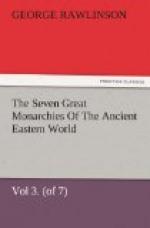Again, there are traces of a vast expansion, apparently at a very early date, of the Median race, such as seems to imply that they must have been a great nation in Western Asia long previously to the time of the Iranic movements in Bactria and the adjoining regions. In the Matieni of Zagros and Cappadocia, in the Sauro-matae (or Northern Medes) of the country between the Palus Maeotis and the Caspian, in the Maetae or Maeotae of the tract about the mouth of the Don, and in the Maedi of Thrace, we have seemingly remnants of a great migratory host which, starting from the mountains that overhang Mesopotamia, spread itself into the regions of the north and the north-west at a time which does not admit of being definitely stated, but which is clearly anti-historic. Whether these races generally retained any tradition of their origin, we do not know; but a tribe which in the time of Herodotus dwelt still further to the west than even the Maedi—to wit, the Sigynnae, who occupied the tract between the Adriatic and the Danube—had a very distinct belief in their Median descent, a belief confirmed by the resemblance which their national dress bore to that of the Medes. Herodotus, who relates these facts concerning them, appends an expression of his astonishment at the circumstance that emigrants from Media should have proceeded to such a distance from their original home; how it had been brought about he could not conceive. “Still,” he sagaciously remarks, “nothing is impossible in the long lapse of ages.”
A further argument in favor of the early development of Median power, and the great importance of the nation in Western Asia at a period anterior to the ninth century, is derivable from the ancient legends of the Greeks, which seem to have designated the Medes under the two eponyms of Medea and Andromeda. These legends indeed do not admit of being dated with any accuracy; but as they are of a primitive type, and probably older than Homer, we cannot well assign them to an age later than b.c. 1000. Now they connect the Median name with the two countries of Syria and Colchis, countries remote from each other, and neither of them sufficiently near the true Median territory to be held from it, unless at a time when the Medes were in possession of something like an empire. And, even apart from any inferences to




